Runpei Dong
AlphaOne: Reasoning Models Thinking Slow and Fast at Test Time
May 30, 2025Abstract:This paper presents AlphaOne ($\alpha$1), a universal framework for modulating reasoning progress in large reasoning models (LRMs) at test time. $\alpha$1 first introduces $\alpha$ moment, which represents the scaled thinking phase with a universal parameter $\alpha$. Within this scaled pre-$\alpha$ moment phase, it dynamically schedules slow thinking transitions by modeling the insertion of reasoning transition tokens as a Bernoulli stochastic process. After the $\alpha$ moment, $\alpha$1 deterministically terminates slow thinking with the end-of-thinking token, thereby fostering fast reasoning and efficient answer generation. This approach unifies and generalizes existing monotonic scaling methods by enabling flexible and dense slow-to-fast reasoning modulation. Extensive empirical studies on various challenging benchmarks across mathematical, coding, and scientific domains demonstrate $\alpha$1's superior reasoning capability and efficiency. Project page: https://alphaone-project.github.io/
Perception in Reflection
Apr 09, 2025
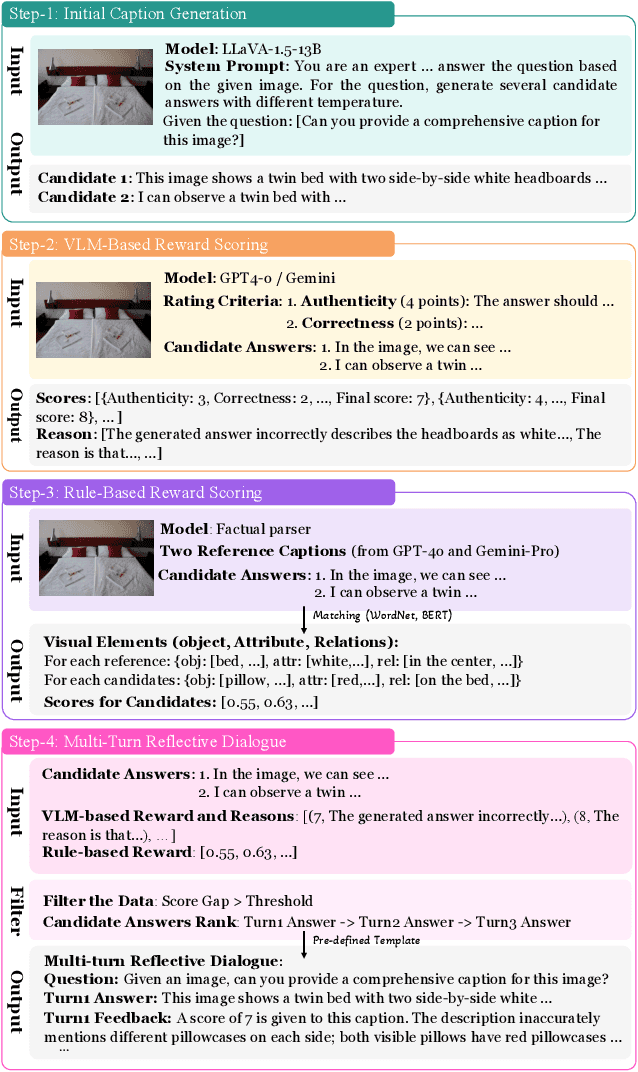
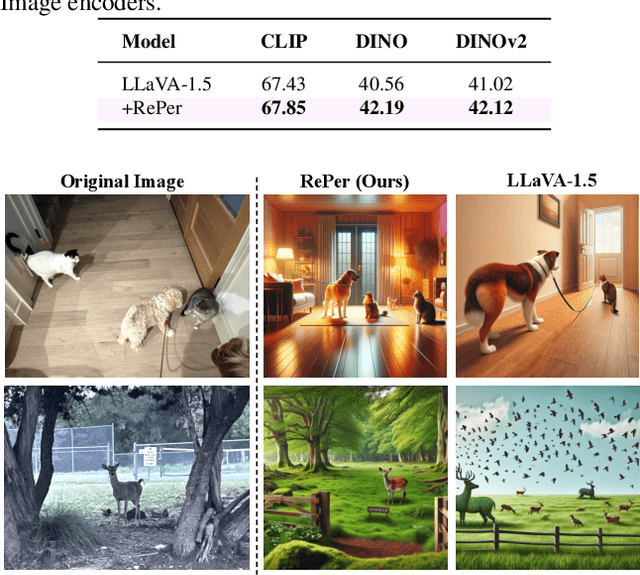

Abstract:We present a perception in reflection paradigm designed to transcend the limitations of current large vision-language models (LVLMs), which are expected yet often fail to achieve perfect perception initially. Specifically, we propose Reflective Perception (RePer), a dual-model reflection mechanism that systematically alternates between policy and critic models, enables iterative refinement of visual perception. This framework is powered by Reflective Perceptual Learning (RPL), which reinforces intrinsic reflective capabilities through a methodically constructed visual reflection dataset and reflective unlikelihood training. Comprehensive experimental evaluation demonstrates RePer's quantifiable improvements in image understanding, captioning precision, and hallucination reduction. Notably, RePer achieves strong alignment between model attention patterns and human visual focus, while RPL optimizes fine-grained and free-form preference alignment. These advancements establish perception in reflection as a robust paradigm for future multimodal agents, particularly in tasks requiring complex reasoning and multi-step manipulation.
SoFar: Language-Grounded Orientation Bridges Spatial Reasoning and Object Manipulation
Feb 18, 2025



Abstract:Spatial intelligence is a critical component of embodied AI, promoting robots to understand and interact with their environments. While recent advances have enhanced the ability of VLMs to perceive object locations and positional relationships, they still lack the capability to precisely understand object orientations-a key requirement for tasks involving fine-grained manipulations. Addressing this limitation not only requires geometric reasoning but also an expressive and intuitive way to represent orientation. In this context, we propose that natural language offers a more flexible representation space than canonical frames, making it particularly suitable for instruction-following robotic systems. In this paper, we introduce the concept of semantic orientation, which defines object orientations using natural language in a reference-frame-free manner (e.g., the ''plug-in'' direction of a USB or the ''handle'' direction of a knife). To support this, we construct OrienText300K, a large-scale dataset of 3D models annotated with semantic orientations that link geometric understanding to functional semantics. By integrating semantic orientation into a VLM system, we enable robots to generate manipulation actions with both positional and orientational constraints. Extensive experiments in simulation and real world demonstrate that our approach significantly enhances robotic manipulation capabilities, e.g., 48.7% accuracy on Open6DOR and 74.9% accuracy on SIMPLER.
Learning Getting-Up Policies for Real-World Humanoid Robots
Feb 17, 2025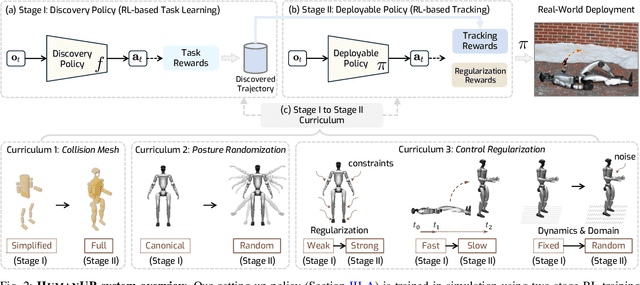
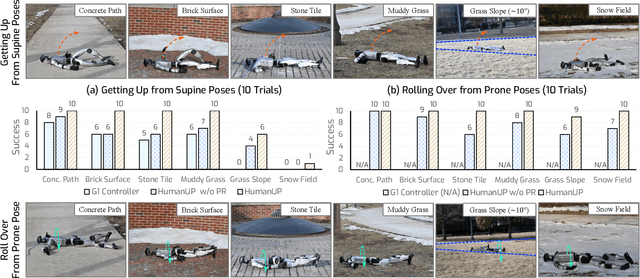
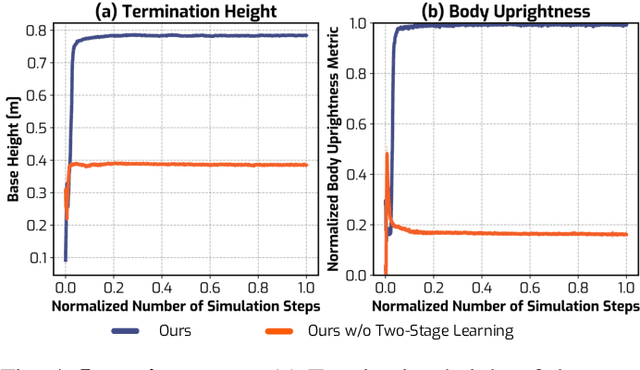
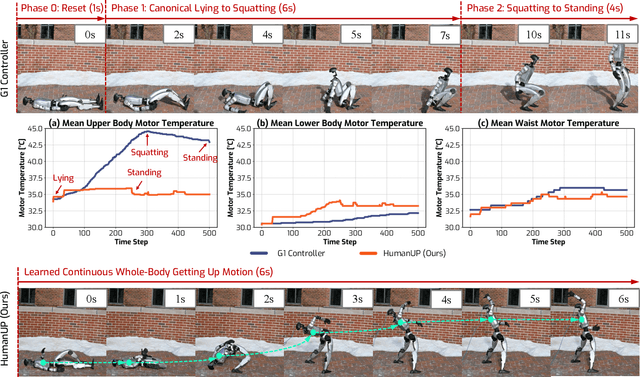
Abstract:Automatic fall recovery is a crucial prerequisite before humanoid robots can be reliably deployed. Hand-designing controllers for getting up is difficult because of the varied configurations a humanoid can end up in after a fall and the challenging terrains humanoid robots are expected to operate on. This paper develops a learning framework to produce controllers that enable humanoid robots to get up from varying configurations on varying terrains. Unlike previous successful applications of humanoid locomotion learning, the getting-up task involves complex contact patterns, which necessitates accurately modeling the collision geometry and sparser rewards. We address these challenges through a two-phase approach that follows a curriculum. The first stage focuses on discovering a good getting-up trajectory under minimal constraints on smoothness or speed / torque limits. The second stage then refines the discovered motions into deployable (i.e. smooth and slow) motions that are robust to variations in initial configuration and terrains. We find these innovations enable a real-world G1 humanoid robot to get up from two main situations that we considered: a) lying face up and b) lying face down, both tested on flat, deformable, slippery surfaces and slopes (e.g., sloppy grass and snowfield). To the best of our knowledge, this is the first successful demonstration of learned getting-up policies for human-sized humanoid robots in the real world. Project page: https://humanoid-getup.github.io/
Taming Teacher Forcing for Masked Autoregressive Video Generation
Jan 21, 2025Abstract:We introduce MAGI, a hybrid video generation framework that combines masked modeling for intra-frame generation with causal modeling for next-frame generation. Our key innovation, Complete Teacher Forcing (CTF), conditions masked frames on complete observation frames rather than masked ones (namely Masked Teacher Forcing, MTF), enabling a smooth transition from token-level (patch-level) to frame-level autoregressive generation. CTF significantly outperforms MTF, achieving a +23% improvement in FVD scores on first-frame conditioned video prediction. To address issues like exposure bias, we employ targeted training strategies, setting a new benchmark in autoregressive video generation. Experiments show that MAGI can generate long, coherent video sequences exceeding 100 frames, even when trained on as few as 16 frames, highlighting its potential for scalable, high-quality video generation.
Positional Prompt Tuning for Efficient 3D Representation Learning
Aug 21, 2024Abstract:Point cloud analysis has achieved significant development and is well-performed in multiple downstream tasks like point cloud classification and segmentation, etc. Being conscious of the simplicity of the position encoding structure in Transformer-based architectures, we attach importance to the position encoding as a high-dimensional part and the patch encoder to offer multi-scale information. Together with the sequential Transformer, the whole module with position encoding comprehensively constructs a multi-scale feature abstraction module that considers both the local parts from the patch and the global parts from center points as position encoding. With only a few parameters, the position embedding module fits the setting of PEFT (Parameter-Efficient Fine-Tuning) tasks pretty well. Thus we unfreeze these parameters as a fine-tuning part. At the same time, we review the existing prompt and adapter tuning methods, proposing a fresh way of prompts and synthesizing them with adapters as dynamic adjustments. Our Proposed method of PEFT tasks, namely PPT, with only 1.05% of parameters for training, gets state-of-the-art results in several mainstream datasets, such as 95.01% accuracy in the ScanObjectNN OBJ_BG dataset. Codes will be released at https://github.com/zsc000722/PPT.
DreamBench++: A Human-Aligned Benchmark for Personalized Image Generation
Jun 24, 2024



Abstract:Personalized image generation holds great promise in assisting humans in everyday work and life due to its impressive function in creatively generating personalized content. However, current evaluations either are automated but misalign with humans or require human evaluations that are time-consuming and expensive. In this work, we present DreamBench++, a human-aligned benchmark automated by advanced multimodal GPT models. Specifically, we systematically design the prompts to let GPT be both human-aligned and self-aligned, empowered with task reinforcement. Further, we construct a comprehensive dataset comprising diverse images and prompts. By benchmarking 7 modern generative models, we demonstrate that DreamBench++ results in significantly more human-aligned evaluation, helping boost the community with innovative findings.
ShapeLLM: Universal 3D Object Understanding for Embodied Interaction
Mar 06, 2024



Abstract:This paper presents ShapeLLM, the first 3D Multimodal Large Language Model (LLM) designed for embodied interaction, exploring a universal 3D object understanding with 3D point clouds and languages. ShapeLLM is built upon an improved 3D encoder by extending ReCon to ReCon++ that benefits from multi-view image distillation for enhanced geometry understanding. By utilizing ReCon++ as the 3D point cloud input encoder for LLMs, ShapeLLM is trained on constructed instruction-following data and tested on our newly human-curated evaluation benchmark, 3D MM-Vet. ReCon++ and ShapeLLM achieve state-of-the-art performance in 3D geometry understanding and language-unified 3D interaction tasks, such as embodied visual grounding.
DreamLLM: Synergistic Multimodal Comprehension and Creation
Sep 20, 2023Abstract:This paper presents DreamLLM, a learning framework that first achieves versatile Multimodal Large Language Models (MLLMs) empowered with frequently overlooked synergy between multimodal comprehension and creation. DreamLLM operates on two fundamental principles. The first focuses on the generative modeling of both language and image posteriors by direct sampling in the raw multimodal space. This approach circumvents the limitations and information loss inherent to external feature extractors like CLIP, and a more thorough multimodal understanding is obtained. Second, DreamLLM fosters the generation of raw, interleaved documents, modeling both text and image contents, along with unstructured layouts. This allows DreamLLM to learn all conditional, marginal, and joint multimodal distributions effectively. As a result, DreamLLM is the first MLLM capable of generating free-form interleaved content. Comprehensive experiments highlight DreamLLM's superior performance as a zero-shot multimodal generalist, reaping from the enhanced learning synergy.
VPP: Efficient Conditional 3D Generation via Voxel-Point Progressive Representation
Jul 28, 2023



Abstract:Conditional 3D generation is undergoing a significant advancement, enabling the free creation of 3D content from inputs such as text or 2D images. However, previous approaches have suffered from low inference efficiency, limited generation categories, and restricted downstream applications. In this work, we revisit the impact of different 3D representations on generation quality and efficiency. We propose a progressive generation method through Voxel-Point Progressive Representation (VPP). VPP leverages structured voxel representation in the proposed Voxel Semantic Generator and the sparsity of unstructured point representation in the Point Upsampler, enabling efficient generation of multi-category objects. VPP can generate high-quality 8K point clouds within 0.2 seconds. Additionally, the masked generation Transformer allows for various 3D downstream tasks, such as generation, editing, completion, and pre-training. Extensive experiments demonstrate that VPP efficiently generates high-fidelity and diverse 3D shapes across different categories, while also exhibiting excellent representation transfer performance. Codes will be released on https://github.com/qizekun/VPP.
 Add to Chrome
Add to Chrome Add to Firefox
Add to Firefox Add to Edge
Add to Edge